Understanding the Multifaceted Landscape of Pediatric Condition Management
Effective management of pediatric conditions, including prevalent neurodevelopmental disorders like ADHD, requires a multifaceted, evidence-based approach tailored to individual needs. This article explores comprehensive diagnostic methods, current treatment modalities, behavioral and pharmacologic therapies, preventive strategies, and resources supporting caregivers and health professionals to optimize child health outcomes.
<!-- VIDEO:eyJsaW5rIjoiaHR0cHM6Ly93d3cueW91dHViZS5jb20vd2F0Y2g/dj1yU3JwZUFtQ01OWSIsImltYWdlVXJsIjoiZGF0YTppbWFnZS9qcGVnO2Jhc2U2NCwvOWovNEFBUVNrWkpSZ0FCQVFBQUFRQUJBQUQvMndDRUFBa0dCd2dIQmdrSUJ3Z0tDZ2tMRFJZUERRd01EUnNVRlJBV0lCMGlJaUFkSHg4a0tEUXNKQ1l4Sng4ZkxUMHRNVFUzT2pvNkl5cy9SRDg0UXpRNU9qY0JDZ29LRFF3TkdnOFBHamNsSHlVM056YzNOemMzTnpjM056YzNOemMzTnpjM056YzNOemMzTnpjM056YzNOemMzTnpjM056YzNOemMzTnpjM056YzNOLy9BQUJFSUFGTUFsQU1CSWdBQ0VRRURFUUgveEFBY0FBQUNBd0VCQVFFQUFBQUFBQUFBQUFBQUJnUUZCd0VEQWdqL3hBQkNFQUFDQVFNREFnUUJDQVlJQmdNQUFBQUJBZ01BQkJFRkVpRUdNUk5CVVdFaUZDTXlRbkdCa2NFVkpGT1NvYkVXTTFKaWNuUHc4VU5qb3RIUzRRYzBOZi9FQUJrQkFBTUJBUUVBQUFBQUFBQUFBQUFBQUFFQ0F3UUFCZi9FQUNnUkFBSUNBUU1DQmdJREFBQUFBQUFBQUFBQkFoRURFaUV4RTFFRUZFRlNZYUVpUWdVejRmL2FBQXdEQVFBQ0VRTVJBRDhBM0dpdks1bmp0b0pKNW0yeHhxV1krZ0ZVUDlMSWQyQnB1b0huajVvYzg0OWFWeVM1RWxPTWVXTWRGTGE5WFFOamJwdW9IUGI1dGVmNDBKMWZBNEJYVHRRSUlCQkVhODU3ZWREWEVYcjQrNHlVVXRucTZBSEIwM1VjNUkvcTE3anY1MWFhVHEwR3BvNWlTV040OGI0NVZ3d3oyUDMwVkpNTWNzSk9reXdvb29waWhsMm94Q0cvdVlRTUJKV1VEMnpWbUdMV0FjOXpGK1ZSTmZHTmF2Qi96RFVpRG5UQi9nYjg2elI1Wm13YlRhSFdFSDVQSHo5UWZ5cUpyUDhBOVpQODFmenFYQWYxZU0vM0IvS29Pdnp4VzFoNDF4SXNjU1NLV2R1QUJXZzFGSzQrZWY4QXhHdnE0SDZvL3dCbExOdjF0bzExZnRDc3JvV2wySXpMdzNKNXo1ZmY2MHlTU0s5cStDRHg1R3BuWFpXcUlBcGE0UkhSQnVBZGM4aWxDU3dzYnBudXJzdytKS3haaVR0R1Q1VTJYVnMxemJTcEhJMGNtMGxTRDU0OCtEeFdWYXpvT3VJN3p6L3JpRDRpOXUrOExubjZQY2QvU2xwUGxsWTM2REYrajlKZ2xWVEs4YlpId3BJM24yN2RxdWJDSjROb1RJak80bmU3T1FNZXBOSlBUODl4OHEvUlU5dzF1NElJVmxEQUVlUnBwaHZieUhlRlNLWmV5dXlsZVBzRks0dE9obXowUlFNaGpnN2p4OTlGZUxTM01wM3RGQ0NmUW1pZ0N6Ykx1M2p1N2VTM21HNk9SU3JEMklxZ2JwUUhqOUtYbU01QUlRNDVCOVBVQ3IyK2FaTE9kN1ZCSk9zYkdKRDJac2NEOGFvVGQ2dUpvQkVMaVZDSStaTFhidkpjaVFQd05tMWNFZXY5NnRXaFNNazR4ZktEK2lZMkJmMHJlYlFBQU1MNWR2TDJvajZURVNJc2VxWFlWQmhSaE1Ea0gwOVFLalJYblZFc0tLWUFrcFJFSmFNS0MrZmliendDQ09NY1lOZmJYblVTenVzc1I4STNJVU5IRm41dk1nSitpY0RpUHVEOUx1UEk5RmZCUHA0K3hJL29zd0pJMWE4Qkp6bjRlLzRlNXF5MGpTWXRNV1FyTEpOTEtSdmtrSXljZGh4NlZUTmU5UStNZ2t0dkRoTWtZTFJvV08wbWJjVDhKd2ZoaTR3ZS9mbkkrV3Yrb1ZSMWt0M0pYRHFZNGVaRkxINFJ3UUdBR09lT3h5TTVITEZReWhDTHRJYmFLVnJpODZnRWN5eHdISVNTUkhFUThtWlFtT2Vmb3RuQjR6VEZaczdXc1RTNThRb0MyNFlPY2ZZUDVEN0tMalJWT3pQZW9mOEE5dTgvelB5RlNMWVowNGY0Ry9PcXJxaTVlTHFHK1FBY1NlbnNLcUpPcHJpMUhnYkUyS01janZuL0FIck5GUFV6Tmgvc2thMWNYU1dPbFNYY3VUSEJibVJzZHlBdWF4UFZ1dE9vZXBDK21sWWZCbmJJaGlqd0FQTExkL3ZxNHZldE5VMVhTcDlMVllmMWlGb2VFT2NFWTlmVHpxSDBjMW5CWkc3bXQxK1VZTWJ5THlTTS93QS9lbnlTMG8zNDRLYnBtZmFyWlQ2YmZ6V2x3MFlkZWVPUnp5SzBYb0RVTGlmVDFobWs4VGFTQjhlNGdlaDlLWCtwdFB0TDdYcmcvUFFrQlFCNFpBZkFIeEFudjZWWjZIZTJlaXFxUVd6TUY3c1dHV09NWlBGSGR4Uk9rcGJjRGpjelJ4Z0pMSUU4UTdRQ2NidmIzcUJQTTFyYnNUYWhmRStiamFORGlUZ2tBL2dhcWJucUdHYmUzaFRBRTUyK0tNRC9BS2Z6clJKYlJOVHRZbVYxampEQnVSNUVWT1dOeVZGWVRVWFpqblRYU3VyYWhyOGQ3ZGtSa1RGbTNIbCsvcDVVNjMybnpXV0ZsaXd2MVdIS21teTNzazB5YkdkN1NaeGdkbDQvbWFpZFJJbDNwRjFDNVpSamdqdXB6d1JUVTYvSUVtbTloUUlHZXdvcXVYU0wyUElqdnh0Sno4WCt4b3BSZFNOeXZSSWJTWVFNNnltTmdoUUFzRGpqR2VNL2J4Uzc4azE1N2ZJbGxpbU1VYTdXbUJBYnhmako3L1V3ZTV4bkFKUE5NR29SeVRXVnhGQzIyVjRtVkd5UmhpT0RrZHFXSDBQWG1qa1JkVFZTZkQyTVpwR3dJOSszampsajRaYjFPNEhjTytxQkdSNitEMUpJazRjdWdhMDJSa1NvSEV5cXBERUFZRzVpNDc5Z3ZBcnQzRHI4YlhZdC9sTXNZbUhoQVNJQzhmaGtBQWx2N2UwbjZKeDJKN1Z5YlJ0YWthZEUxQlZodURJV3pOSVRGdmtVa0xqQnhzWEE1QkJKd2ErazB2WFBHM3pYY0xGa1FOSUo1QmpBVElWY1lBSlZ6bnVkMktlMThBQ2FMWHpOTDhVNm8wY3V3eEdOdHJiMzI5M1g2dTMvQUxxZWE5N2lIWEpZWW5nY3d5TFlFRkRJRytmSTlleEk5U0NLaEhSTmNSR2pXL1dTTWJHQ3ZjeUFzZm5DNmxzWndHWldIcUJ0T0FLbDZocHVzM0VzRWtGNUZFSXJVeE5Hc2pqZTdLd1k1OWpzSUpCUEI3WjVHM3djZk50RHJ2eSsxa0xUSlpySWQ4VXJvMG13OWcyRGdrY252Mjl4VEthVjQ5RzFnTkdmbC9ob3JaOElYRHlBTHZpTzNjd3lSaEhQbGpmdDdWUDZlc0w2eVdYNWRNSDNCQUZFN3k4ak81c3NCak9SOEk0NDk2V1ZQY01SUTZ0MHpQVWMwemtlSEx0Y3J5TWpiaitZcFkxZnAwL295ODFSTGc0aTVXRlk4bmFNWkpPZlRudDVWcFhXbHJtM2l1MUgwRHNmN0QyL2ovT2xuU0prdTF1Yk5aRUt6UnNwenpnNEk3ZmZXYTlNeUVham0zOVJUNkR2WVV1TDFXUXRJWWNxM29CM0gzNUg0Vlo5Sm16dTlJZ2FLTUZnV0RBRE9EdVBlbERUcDA2ZDZndTRieVJWU0JqRnU3N2dUd2NlbUJWbjA5YVdGbkxMTFo2dkU4VXh6NGNvWlJqMFBPRDM3NHFqbCtWU1d4YkxpYmc1NDMrUmNkWVhNTW1ub0lnU1k3clp1eDJPMDVGSytSc3pWMUpaVEMzbHN0UkRSUVN6K0pGY0t3ZFZ5ZU9mYlB0eFM3ckt5YVJNSVoyVmxZRXh5b2ZoWUE0UDJFSGdqeW93bnFiUldPSHB3UjYyWnRYdkVGN0xzdHhrdjdqMCsrdHcwc21PeGhhUmNNVnlSakJCUFA0MStmTk52WVgxV3o4U043aFBHVW1HUEc2VG42SXo2MXVzK3VHQ3lhNWJUN2xaUERKVWZBY0hIQU9Hei9DbWRKMjJIbFVrVm1yYTA5dmZ5RmVZNGo0V2RwSTQ5L3RKcnpuMUNLOTBLOW1RbmVtTjNQR0NlTVZUNlMxelBEbTRXTUJ1NTJzU2Z0NXFMcTlycW5naTAweXlpbHQ1SDhTUm9TcUhjT3dPNDl2VEh2V1hWY3RtV25Hb2NIa0xuTkZWeTZYMUN2QTBlNGI3SlkvL0FDcnRIUkl6VWJycWthemFiZFJTU0xFand1clNQMlFGU01uMkZMdGhaMkZyZXZkUjYxYStGSkZNenFzaThGMkFFZ09lT0ZDbjFJSHZUWVJrVXZIcGVMd2hHdDFNcWkyZ3QrMzdKdHl0eGpuMS9oaXRjR3EzWUpKa0ZkSHRVZ2hZNmpaUXJiQ01QNEFDSSt5UkhKYm51UUIrOEs5WU9tcFBrSXQxbnM1N2RuaGxIaVFGMVlwRWtmSXpnZzdjMUtsNlhnZWQ1aGNTQnBGYnhCdEJWbUxLUTNydUczQUlPZTNvTVhsdEVZYmVPSXlQSVVVS1hmNlRZSGMrOUZ6N01DaUtMOUVFaVlDOFdVeWlBTTA4V1MzaGVEamQvYUo4RTV6bkdSakh4YnJPeTBHYXl2NUx1QzZUNXhKL216R2NDUjNCRERudGhWQkhzRHh6bGdvb2RTVENvSkNpT2ozU0dLT08rNWhSMGlkb3Vkc2hReUE0eG5KVmo5cEI4cXROQzBZNlhjWFV1K01pYy9SaWoyRDZidHVibmxqdnhuMFVWZFVVSE52Wm5LS1JEMWF5WFVOTnViUnYrTEdWQjlENUg4Y1ZpNGsyT1JreHlxY0hCMmtIOHEzU3NnNnV0QmE5UlhzZTBiSGZ4RjQ4bUdUL0FCSnFPUWg0aGNTRVRWZEkrVjM0bXQ1dHN6LzFnY2xzNDg2bFdscE5hU1luS3NwR0F3NTU5RC9yeXFjSTBnTXV3QmN1VCtOUnJ0d1ljNU80RUZTUEkxZkhrYW92cFU0MmZGL2NYT3lKSVpnMXVoUGlSSHVCNmorTmR1UmFTUlJOSTY3UjJKUEF6ak9NOXZLbUdTeEhVdWxXMDJuVzZwZFEvd0JZcW9NOERCeDI5dTVxcjZUa0Z2cWx4b2M4S3plTXhqSHcvajkyT2FYcXB4ZFJLZEo2bGNpc0N4YWZjeDNNQkcrUExnNEhseCtkYWNKMm50QUZJTzVjalAyVWdkVWFIYzZGdVdaNHBZK1NwVS9FVVBISXErMHZVRWZwdUdSNTRsa0VRemx4a0hGWjg2dEpsc1hKWjZMWVp0MnZaMXcwckZ0dnB6amoyODZnOVczSHlmVFNiZVY0cmdTS1VLT1ZQZko3ZjNjMHpERWx2dFU3Y2pnanlySTcyNXU3cSttK1V2d3Jzb1VIaFJrOXFURkM1WDJHeVNxSk1sdVdta01rMHJTdWU3dVNTYUtoTEVBQUE3L3ZtaXRsR2V6OU1VVmlualRmdHBQM3pSNDAzN2FUOTgxbDYvd2VmNTFlMDJ1aXNhczF1YnU2aXQ0cG5EeXR0WGM3WXo5MmFzOWRzLzBRcVdzbDAwbDV0RHNVTEFBSFBISjl2YWlzMXE2R1hpN1RscDJOU29ySzRyRjNpaGJkZXQ0a0xTZUtyZkFXMnVRZzk4cUIzOWVCWHFOSGxOeUVOMU1xTVhDc1MyMWNCc2JueGdjcjJ4Mm85VjlobDRsdjlUVDZLeWlDd2xtZ2svVzVVbVNaMHhJU29JVUFuUDhBWjdtdldUUnJtT2NRdGZPR1p3aWdoaGs0SjlmUlRqMTRydXErd1BNdjIvWnFWWnAvOGtJRjErSng5ZTJYUDNNMy9xb3NOZzdQZFFQZHplT2swY1VaQklIeEJpU1IzemhlM3I5dGVFMm5NczF1czg3TzBzeXhLcktRd0JDTnpuc2ZuQU1ZNzU5S1dXUnRjRThtZHpqV2tWZFFoak15dWR3WXJqS3NSVmJLaUZnTXNmWXNUV2hKMCs4cnFzY3dKT01yc0pJeU1nZW4zOFZ3ZFBsMFo0V0pWWWtreTBXTTVHU0J6L3JGTkhJMHFvZUhpSlJqV2tyT2h0WDAzUjF2QmQzQ1c1Y3FVK0FuSTV6Mis2dTZ6MWJwcmFxTDNTdE9SNTFCVnJtVEtGL3VINTgxTnZOSFMydFpwdkY4UXhzb3dzWEdDenFTVDVjb2Y0ZXRmZHgwL0pib3pPYzdZdzJCQ1NjL0gzeDJBMmQvY2V0ZDFmZ2J6VDl2MksvVVBWRjFyTms5dGNSUmJEamFSaks0SVBINFV2YVJJSTU1YllnRVRMeHo5WVZwYmRPdVBIeklCNEp3Y3dNTW40dXc3NCtIZytmNDE0MzJodlpRU3pOZ2lPUUtmbThjRUFnOS9mMzk4VUpaTGpWQlhqSlIzMC9aY1dNeWkyalVTSXhDZ0hEQTgxa09vNnBhVytvWFN5UDhZbWNGUjNCeWVLZE1EMEZjTWFINmkvZ0tsanlhTEJMK1JVdjEreEVHdlEvVmpKSHJrVVU5ZUhIK3pUOTBVVmJ6SzdDZWZYdCsvd0REN29vb3JJZWNmVU1za01xeVF1eVNMeXJLY0VHaVNSNVczU3V6dGdMbGprNEhBb29vK2dVL1ErVjVBb1AwYys5RkZBUzJkSUhGY0hJSjh4UlJYSE5zTy8zbWp6cnRGZDZIV2M5ZnNyZ1BmMkZkb29XZGJBR3VmN1YyaW1PVFlIZ2NmWlJra25uem9vb0k2MkZGRkZjTUZGRkZjY2YvMlE9PSIsInRpdGxlIjoiQ29tcHJlaGVuc2l2ZSBTdHJhdGVnaWVzIGZvciBNYW5hZ2luZyBBREhEIGluIENoaWxkcmVuIC4uLiIsInNuaXBwZXQiOiJBcmUgeW91IGEgYmVoYXZpb3JhbCBoZWFsdGggcHJvZmVzc2lvbmFsIGxvb2tpbmcgdG8gZW5oYW5jZSB5b3VyIHVuZGVyc3RhbmRpbmcgYW5kIHRyZWF0bWVudCBvZiBBdHRlbnRpb24tRGVmaWNpdC9IeXBlcmFjdGl2aXR5IERpc29yZGVyIC4uLiJ9 -->Robust Diagnostic Approaches for Pediatric Conditions
Diagnosing and evaluating pediatric health conditions requires a thorough, multi-faceted approach to ensure accurate identification and effective treatment planning. Healthcare professionals utilize a combination of detailed medical histories, physical examinations, and behavioral assessments to gather comprehensive information about the child's health and development (Common Pediatric Conditions).
One essential aspect of diagnosis involves collecting reports from multiple sources, including parents, teachers, and other caregivers. This multi-informant assessment helps capture the child's behavior across different settings, providing a broader understanding of the symptoms and their impact on daily life. Standardized rating scales, checklists, and validated behavioral questionnaires are commonly used tools that facilitate this process (parents and teachers input).
For neurodevelopmental disorders such as ADHD, clinicians apply the Diagnostic and Statistical Manual of Mental Disorders, Fifth Edition (DSM-5) criteria. These criteria specify the number, type, and duration of symptoms like inattention, hyperactivity, and impulsivity, and require that symptoms cause impairment in social, academic, or other important areas (DSM-5 criteria for ADHD diagnosis).
In addition to behavioral assessments, screening for comorbid conditions is vital. Children with ADHD, for example, often present with other challenges such as anxiety in children, learning disabilities, mood disorders, sleep problems, or autism spectrum disorder. Early detection of these comorbidities can influence treatment choices and improve overall outcomes.
To rule out other potential medical causes of symptoms, additional testing might include laboratory investigations, neuroimaging, or specialized evaluations, especially when symptoms overlap with or mimic other health issues. These tests help exclude underlying conditions such as thyroid problems, seizures, vision or hearing impairments, or neurological abnormalities (ruling out other conditions).
Ongoing monitoring is a crucial component of pediatric diagnosis. As children grow and develop, their symptoms and needs change. Regular follow-up allows healthcare providers to assess treatment effectiveness, manage side effects, and identify emerging comorbidities. This dynamic process ensures personalized and adaptive care, ultimately leading to better health and developmental results for pediatric patients (collaboration with healthcare providers).
By integrating detailed clinical assessments, multi-informant reports, DSM-5 criteria, and targeted testing, healthcare professionals can establish accurate diagnoses and craft comprehensive management plans tailored to each child's unique profile (thorough evaluation for ADHD).
Integrating Evidence-Based Practices in Pediatric Health Management
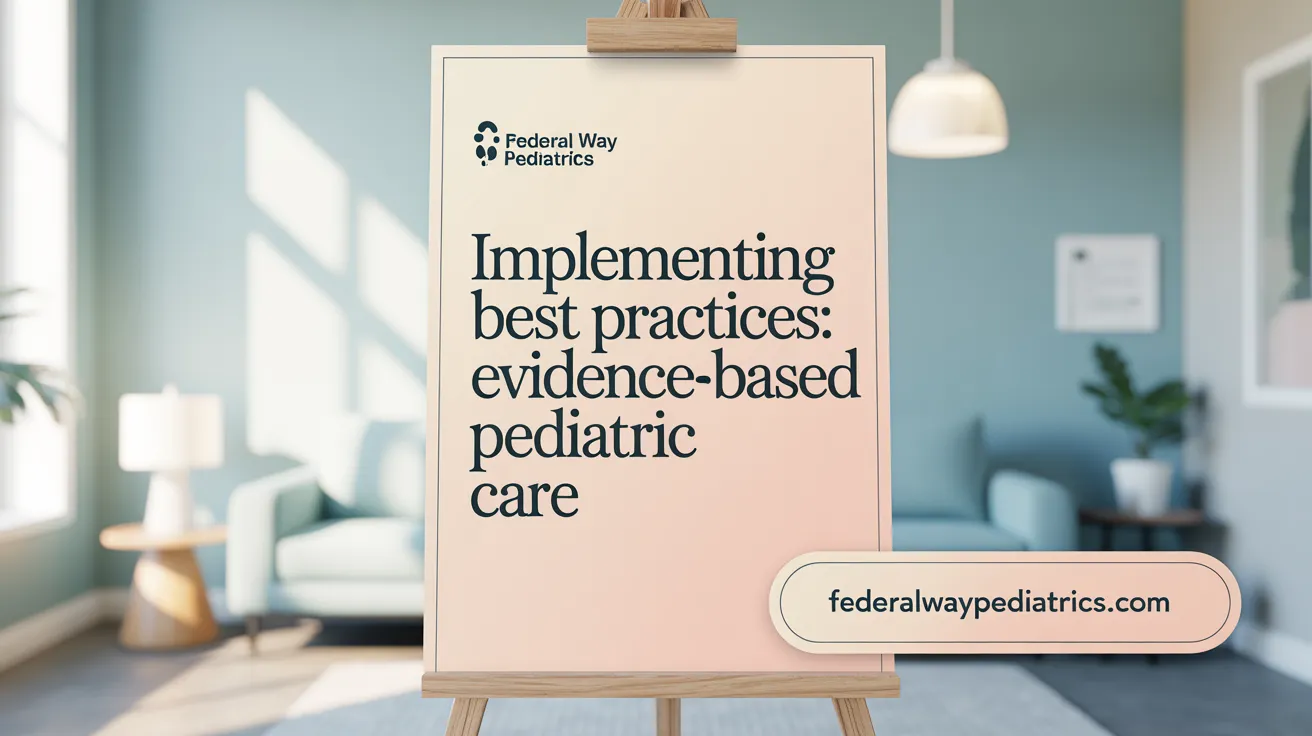 Implementing evidence-based practices in pediatric health management involves a systematic approach that integrates the latest, most reliable clinical evidence into everyday healthcare delivery. Healthcare providers develop and adhere to clinical guidelines rooted in rigorous research to ensure safe and effective care for children.
Implementing evidence-based practices in pediatric health management involves a systematic approach that integrates the latest, most reliable clinical evidence into everyday healthcare delivery. Healthcare providers develop and adhere to clinical guidelines rooted in rigorous research to ensure safe and effective care for children.
A crucial step is framing clinical questions clearly using frameworks like PICO (Patient, Intervention, Comparison, Outcome). For example, questions may focus on the best treatment for ADHD in preschool children or optimal management of childhood pneumonia. This structured approach helps healthcare teams identify relevant evidence sources efficiently.
Once questions are formulated, clinicians conduct targeted searches in reputable sources like systematic reviews, meta-analyses, and databases such as PubMed or Cochrane Library. Critical appraisal tools assess the validity and relevance of individual studies, ensuring that recommendations are based on high-quality evidence.
To translate evidence into practice, organizations often utilize clinical decision support systems integrated within electronic health records. These tools provide real-time guidance to clinicians, encouraging adherence to evidence-based protocols.
Quality improvement methodologies, such as Plan-Do-Study-Act (PDSA) cycles, are employed to test, implement, and refine interventions. These techniques facilitate ongoing practice adjustments, leading to better health outcomes.
Organizational strategies play a vital role, including staff education, mentorship programs, and fostering a culture of continuous learning. Such environments promote openness to practice change and innovation.
Moreover, it is essential to consider socio-cultural factors, health disparities, and ethical considerations in pediatric populations. Tailoring interventions to meet diverse needs enhances acceptance and effectiveness.
By combining these approaches—structured questioning, rigorous evidence appraisal, supportive organizational frameworks, and cultural competence—pediatric healthcare providers can ensure that their practices are aligned with the best available evidence, ultimately improving the quality and safety of child health outcomes.
Current Treatment Modalities and Guidelines for Common Pediatric Conditions
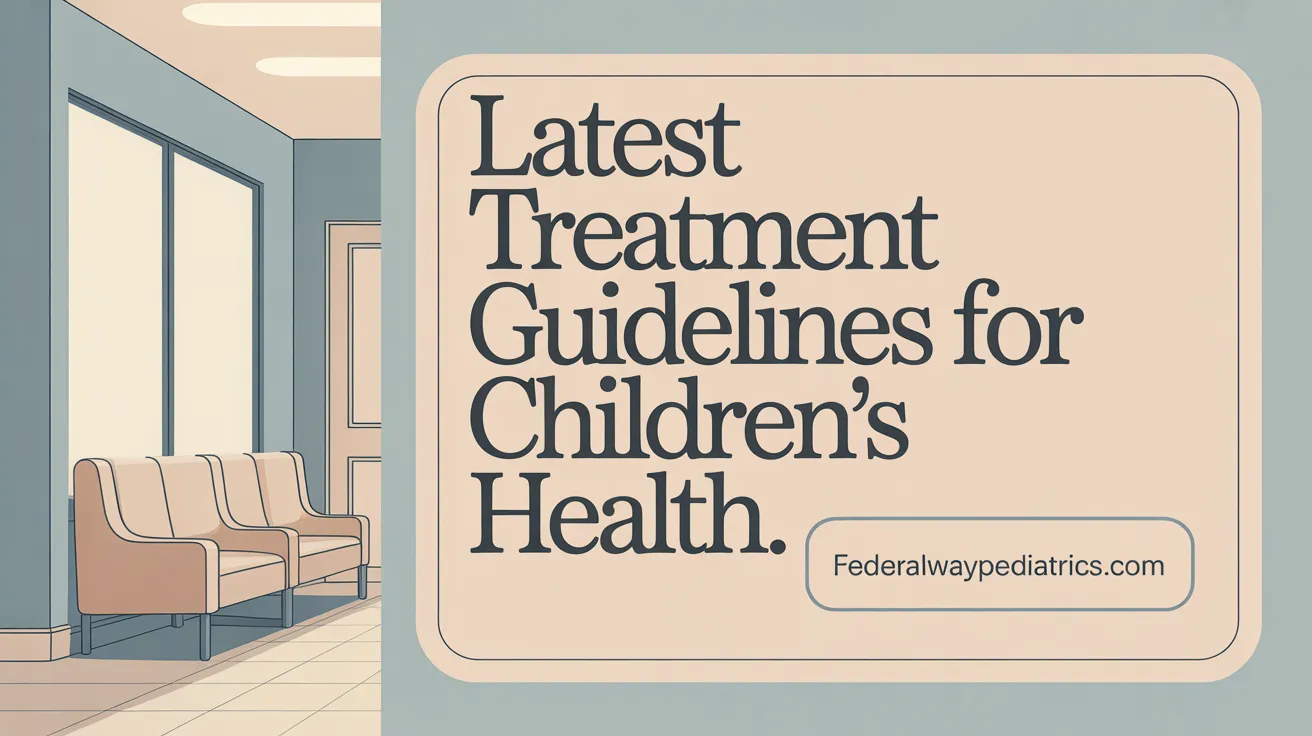
What are the current treatment options and guidelines for managing pediatric conditions?
Managing pediatric health conditions relies heavily on evidence-based guidelines aimed at ensuring safe and effective care. Organizations such as the American Academy of Pediatrics (AAP) and the World Health Organization (WHO) have developed comprehensive standards for diagnosis and treatment, tailored to various common conditions in children.
For infections like sinusitis, otitis media, pharyngitis, and urinary tract infections, guidelines specify criteria for the judicious use of antibiotics. For instance, bacterial sinusitis with persistent symptoms may warrant antibiotics, whereas many viral upper respiratory infections are managed supportively with rest, hydration, and symptom control, avoiding unnecessary antibiotic use.
Supportive therapies are central to treatment, especially for viral illnesses such as colds, bronchiolitis, and influenza. These focus on relieving symptoms through hydration, fever management, nasal decongestants, and rest, with antibiotics reserved for bacterial infections.
Both the AAP clinical guidelines and WHO pediatric health guidelines emphasize the importance of tailored care plans that consider individual patient factors, resource availability, and regional disease prevalence. This tailored approach ensures interventions are appropriate for the setting, whether outpatient or inpatient.
Antibiotic stewardship is a core principle in pediatric care, aiming to prevent resistance and adverse effects. Guidelines advocate for the careful assessment of illness severity, clinical criteria, and diagnostic tests before initiating antibiotics.
Overall, pediatric guidelines promote a balanced strategy—using pharmacologic treatments wisely, prioritizing supportive care when possible, and developing comprehensive, patient-centered management plans. These efforts help achieve optimal health outcomes while minimizing risks associated with unnecessary medication use.
For further details, current pediatric treatment guidelines and management options are regularly updated by professional bodies, reflecting ongoing research and consensus on best practices, such as the CDC Pediatric Health Guidelines, Seattle Children's Hospital programs, and HealthyChildren.org resources.
Behavioral and Psychosocial Interventions in ADHD Management
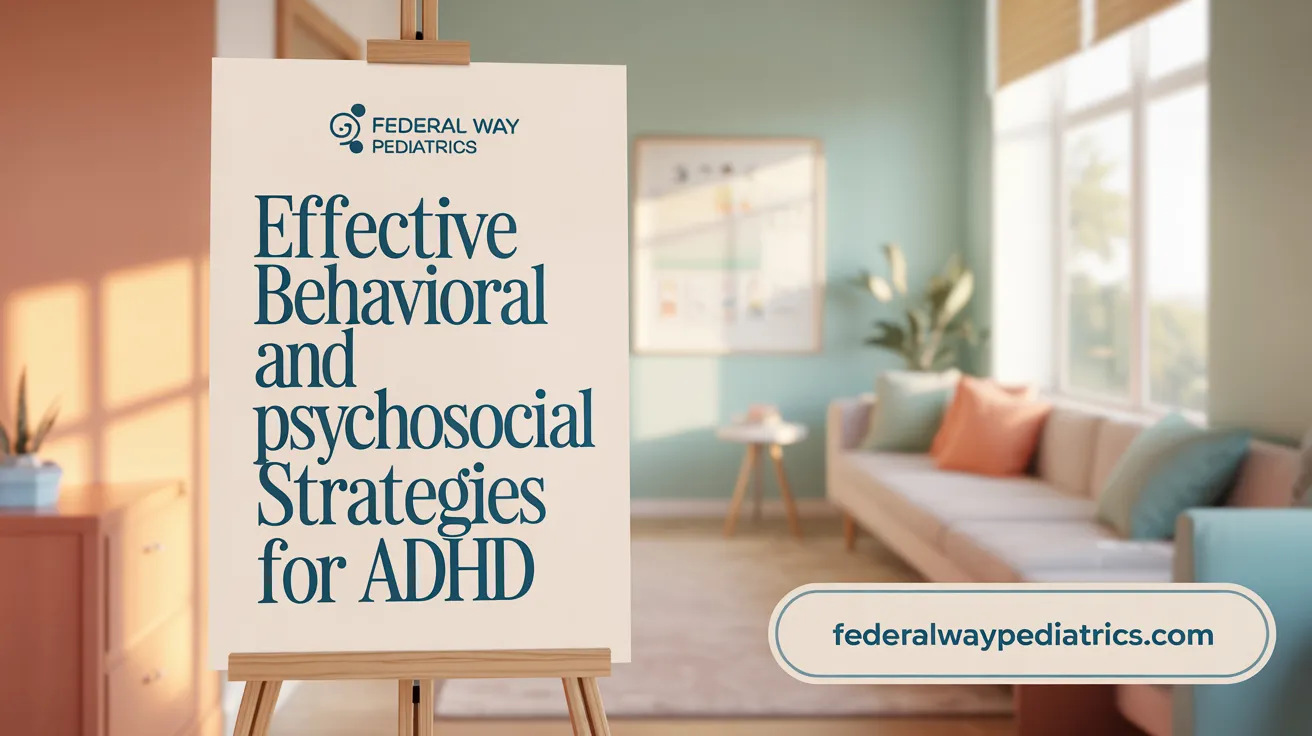
What behavioral therapies and psychosocial interventions are effective for ADHD management?
Managing ADHD often involves more than medication; evidence-based behavioral therapies for ADHD and psychosocial interventions play a crucial role. These approaches aim to modify behavior, enhance social skills, and improve daily functioning.
A primary psychosocial strategy is parent training in behavior management, which educates parents on techniques like positive reinforcement, consistent discipline, and creating structured routines. These methods help reduce oppositional behaviors and support children's development of self-control.
Classroom interventions also support children with ADHD. Teachers can employ strategies such as behavior charts, organizational tools, and individualized education programs (IEPs) to promote focus and diminish disruptive behaviors.
Social skills training is another effective intervention, helping children learn appropriate ways to interact, share, and resolve conflicts. These skills are often taught through group sessions, role-playing, and peer modeling.
Cognitive Behavioral Therapy (CBT) has shown moderate effectiveness for children and adolescents. It assists in developing coping skills, managing negative thoughts, and improving emotional regulation, especially when combined with medication.
While these psychosocial therapies are supported by research, their success depends on consistent application and early intervention. They are most effective when tailored to the child's developmental stage and specific needs.
Collaborative efforts among families, educators, and healthcare providers are vital. Regular communication ensures that strategies are reinforced consistently across environments, leading to improved behavior and long-term benefits.
Although psychosocial interventions significantly support ADHD management, more high-quality studies are needed to optimize their implementation and determine the best ways to adapt them for diverse populations and settings.
Pharmacologic Treatment Approaches for ADHD
ADHD management often involves the use of medications for ADHD, which are highly effective in reducing core ADHD symptoms of hyperactivity, impulsivity, and inattention. The most common pharmacologic options are stimulant medications such as methylphenidate (e.g., Ritalin, Concerta) and amphetamine-based drugs (e.g., Adderall, Vyvanse). These stimulants work by increasing dopamine and norepinephrine levels in the brain, especially in the prefrontal cortex, which enhances attention control and reduces impulsiveness.
In addition to stimulants, non-stimulant medications like atomoxetine (Strattera), guanfacine, and clonidine are available alternatives. Atomoxetine functions as a selective norepinephrine reuptake inhibitor, providing a useful option for children who do not tolerate stimulants or have comorbid tics or anxiety.
Medication choices are individualized based on factors such as response effectiveness, side effect profiles, patient preferences, and the presence of other health conditions. Careful titration and ongoing monitoring are essential to ensure maximum benefits while minimizing adverse effects. Common side effects include appetite suppression, sleep disturbances, and, less frequently, cardiovascular effects such as changes in blood pressure and heart rate.
Long-acting formulations are generally preferred as they provide symptom control throughout the school day, improve adherence, and reduce the need for multiple doses. These include extended-release versions of methylphenidate and amphetamines.
Medication management is complemented by behavioral therapies and psychosocial interventions, forming a comprehensive, multimodal approach. Regular follow-up allows healthcare providers to adjust doses, monitor side effects, and evaluate overall treatment efficacy, ensuring the best possible outcomes for children with ADHD.
Comprehensive Management Strategies for Pediatric ADHD and Co-Occurring Conditions
Managing complex ADHD cases and associated co-occurring conditions requires a comprehensive and multidisciplinary approach tailored to each child's unique needs. Effective strategies begin with thorough assessments that encompass medical, developmental, behavioral, and social factors. Recognizing that children with ADHD often face additional challenges such as anxiety, autism spectrum disorder, or behavioral issues, clinicians should employ validated screening tools and collaborate with families, educators, and mental health professionals.
A key component is the integration of evidence-based interventions, including behavioral therapies like parent training in behavior management, classroom behavioral interventions, and social skills training. Behavior therapy has been shown to produce long-lasting benefits, especially when combined with appropriate medication—most commonly stimulants or non-stimulants—adjusted to the individual’s response and side effects.
Facilitating access to specialized care involves leveraging collaborative care models such as the Family Medical Home and Health Homes, which coordinate services among healthcare providers, mental health specialists, and community resources. This coordination is especially vital for high-risk populations, including children who are homeless, belong to racial or ethnic minorities, or are involved with juvenile justice systems. Trauma-informed, culturally sensitive, and family-centered approaches improve engagement and adherence to treatment plans.
Additional strategies include targeted screening for comorbid conditions, crisis intervention, and community-based supports like supportive housing and tailored school programs. These efforts help address systemic barriers, promote stability, and support the child's overall development. Incorporating psychosocial support alongside pharmacotherapy ensures a holistic treatment plan that optimizes outcomes and enhances quality of life for children with complex ADHD and other systemic challenges.
More information on managing co-morbidities and addressing diverse pediatric populations can be found through health resources and expert guidelines, which emphasize evidence-based, tailored care strategies.
Preventive Measures and Early Symptom Recognition in Childhood Illnesses
Preventive strategies are vital in safeguarding children's health against common illnesses. Ensuring children are up-to-date with all recommended vaccinations for children provides essential protection against diseases like measles, mumps, pertussis, and influenza. Consistent handwashing with soap, especially before meals and after diaper changes or outdoor activities, significantly reduces the spread of germs. Maintaining good hygiene practices at home and in schools, along with routine cleaning and disinfection of surfaces, can decrease infection transmission.
Promoting a balanced diet rich in nutrients, along with adequate sleep and regular medical check-ups, supports a strong immune system. Education of parents and caregivers is crucial; recognizing early signs of illness such as a runny nose, cough, ear pain, vomiting, or mild fever enables prompt response. Parental awareness of symptoms that may indicate severe illness—like high fever above 104°F, difficulty breathing, dehydration, or persistent vomiting—is essential for timely medical intervention (Managing common childhood illnesses, When to seek medical attention for child illness).
Monitoring children for these early symptoms allows caregivers to seek appropriate care swiftly, preventing complications. In settings like schools, improving air quality and implementing routine surface cleaning can further reduce the risk of respiratory infections (Respiratory infection management in pediatric care). Overall, combining immunizations, good hygiene, nutritional support, and vigilant symptom monitoring creates a comprehensive approach to prevent childhood illnesses and ensure early detection when they occur.
Resources and Guidelines for Supporting Families and Healthcare Providers
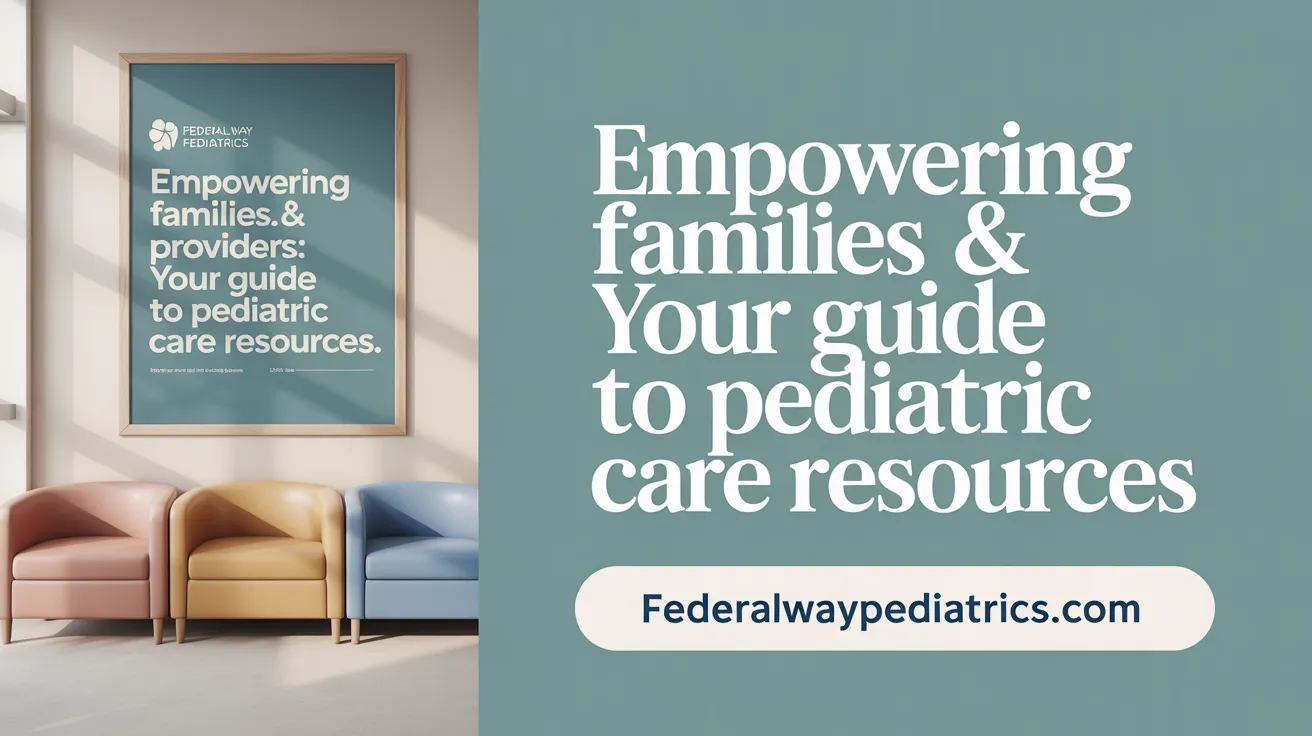 There are numerous authoritative resources and guidelines available to assist both families and healthcare providers in managing pediatric health conditions, including ADHD and common childhood illnesses. Reputable organizations such as the American Academy of Pediatrics (AAP) and the World Health Organization (WHO) develop comprehensive, evidence-based clinical practice guidelines that serve as essential tools for diagnosis, treatment, and management.
There are numerous authoritative resources and guidelines available to assist both families and healthcare providers in managing pediatric health conditions, including ADHD and common childhood illnesses. Reputable organizations such as the American Academy of Pediatrics (AAP) and the World Health Organization (WHO) develop comprehensive, evidence-based clinical practice guidelines that serve as essential tools for diagnosis, treatment, and management.
The AAP’s Clinical Practice Guidelines offer detailed recommendations for conditions like ADHD, emphasizing a systematic approach involving behavioral therapies, medication management, and educational support. These guidelines advocate for early intervention, routine monitoring, and collaborative efforts between parents, schools, and healthcare providers to optimize outcomes.
Similarly, the WHO guidelines focus on management of neonatal illnesses, infectious diseases, and nutritional issues, especially in resource-limited settings. They promote best practices in case management, use of appropriate medications, and preventive strategies to reduce childhood mortality and morbidity.
Supporting families, the Bright Futures Guidelines, 4th Edition, provides practical advice on health promotion, disease prevention, and early detection of developmental or behavioral issues such as ADHD. The guideline emphasizes continuity of care and addresses thematic areas including mental health, nutrition, safety, and family support.
Educational rights and advocacy are also critical. Laws like the Individuals with Disabilities Education Act (IDEA) and Section 504 of the Rehabilitation Act ensure children with ADHD and other special needs access to appropriate educational accommodations and support services. Parents and caregivers are encouraged to understand their child’s rights and work closely with educators to develop Individualized Education Programs (IEPs) and 504 Plans.
Additionally, many healthcare institutions, such as the Children’s Hospital of Philadelphia (CHOP), provide online resources, patient education materials, and referral networks to facilitate prompt access to specialized care and community support.
In summary, utilizing these guidelines and resources enables healthcare providers and families to implement coordinated, evidence-based strategies, ensuring children receive comprehensive care tailored to their developmental and health needs.
Integrating Non-Pharmacological and Alternative Approaches in ADHD Care
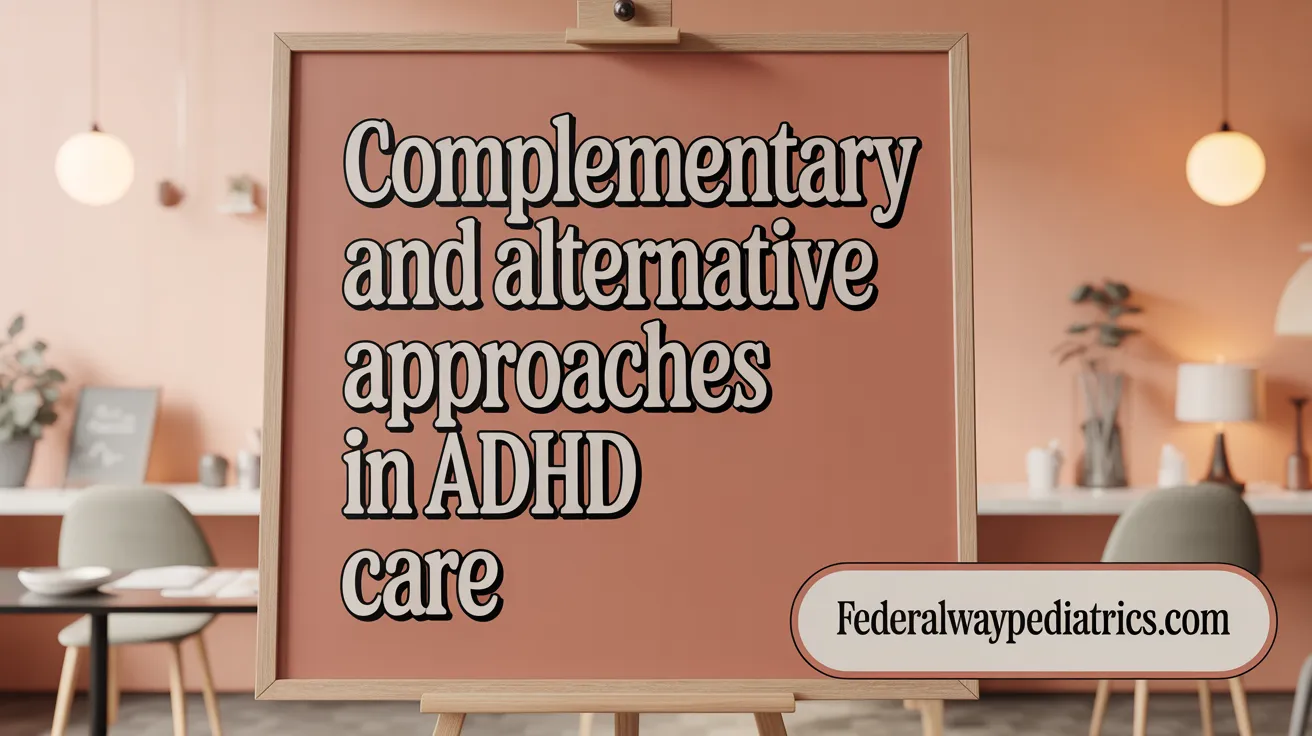
What are the non-pharmacological and alternative medicine approaches to managing ADHD?
Managing ADHD effectively often involves more than just medication. Evidence-based behavioral therapies remain the cornerstone, especially for young children. Parent training in behavior management teaches caregivers techniques such as positive reinforcement, consistent discipline, and structured routines, which can significantly improve behavior and social skills.
Classroom interventions and peer-mediated strategies also support children in educational settings. These include individualized education programs (IEPs) and accommodations under special education laws like IDEA or Section 504, focusing on creating supportive learning environments (educational accommodations for ADHD).
Beyond traditional behavioral approaches, complementary therapies such as neurofeedback—which provides real-time feedback on brain waves—show promise but require more research to confirm long-term benefits. Mindfulness meditation, yoga, tai chi, and outdoor physical activities have been associated with improved attention, emotional regulation, and reduced hyperactivity (mind-body practices for ADHD).
Dietary interventions, including omega-3 fatty acids, vitamin D, and reducing food additives and allergens, have shown some potential in symptom management, although scientific evidence remains mixed. A balanced diet emphasizing healthy habits and avoiding processed foods may support overall well-being.
Other integrative techniques like organizational skills training, cognitive training, and mindfulness-based stress reduction can help strengthen executive functions (non-pharmacologic management of ADHD). Importantly, these approaches are most effective when combined with standard treatments and tailored to individual needs.
While alternative therapies can offer additional support and symptom relief, it’s essential to consult healthcare professionals before initiating such strategies. Personalized, multi-faceted treatment plans are recommended for optimal management of ADHD symptoms, emphasizing safety and evidence-based practices (diagnosis of ADHD and treatment guidelines).
Parenting and Educational Support: Enhancing Pediatric Condition Outcomes
Parenting and Educational Support: Enhancing Pediatric Condition Outcomes
Supporting children with ADHD and other pediatric conditions requires a collaborative approach involving parents and teachers input and collaboration with healthcare providers.
Parent training and advocacy are fundamental. Parents learn strategies like providing clear instructions, establishing consistent routines, and reinforcing positive behaviors. This empowers them to manage daily challenges and advocate for their child's needs within the school system.
School accommodations, such as Individualized Education Programs (IEPs) and 504 plans, are crucial for accessing tailored support. These legal tools help modify curriculum, classroom settings, and behavioral expectations to ensure children can succeed academically and socially.
Building self-esteem is essential for children's overall health. Encouragement through praise, celebrating achievements, and helping children develop strengths in areas like arts or sports support confidence and resilience.
Effective collaboration among caregivers, educators, and clinicians creates a robust support network. Regular communication ensures consistency, monitors progress, and adjusts strategies as needed.
Families face various coping challenges. Strategies include seeking peer support groups, accessing community resources, and practicing stress management techniques to maintain emotional well-being.
Lastly, emphasizing social skills and routine helps children develop important life skills. Structured activities and consistent schedules foster a sense of security and help in developing positive peer relationships.
In summary, integrating parental involvement, educational accommodations for ADHD, and social skill development creates a supportive environment that significantly improves health and educational outcomes for children with pediatric conditions.
Towards Holistic Pediatric Health Management
Managing pediatric conditions such as ADHD demands a comprehensive, multidisciplinary approach that encompasses precise diagnosis, evidence-based pharmacologic and behavioral treatments, preventive strategies, and robust support systems for families and providers. Emphasizing individualized care plans, continuous monitoring, and utilization of authoritative resources fosters improved clinical outcomes and quality of life for children. As research advances, integrating innovative therapies and addressing coexisting conditions will further refine pediatric health management, empowering children to reach their full potential.
